NVIDIA’s GeForce GTX 460: The $200 King
by Ryan Smith on July 11, 2010 11:54 PM EST- Posted in
- GPUs
- GeForce GTX 400
- GeForce GTX 460
- NVIDIA
Overclocking
Last but not least on our tour of the GeForce GTX 460 is a look at the overclocking abilities of the card. As we discussed earlier, NVIDIA is heavily promoting the overclockability of the card to the press, proclaiming that they are regularly able to get most cards up to 800MHz. We’re in a unique situation today to put that to the test, as along with our 2 reference cards, we have an additional 4 vendor cards from our GTX 460 roundup to tinker with. With 6 cards on hand we have a non-definitive but still very useful sample set to work with to verify just how overclockable these cards are, and what kind of a power penalty this entails.
For the purposes of this section we are focusing on the overclockability of the core, but not the memory. NVIDIA’s weaker GDDR5 memory controller coupled with the tendency for memory overclocking to reduce performance through the need to use error detection and retransmission makes memory overclocking much more difficult and often a bust entirely.
As not all of our cards are exactly alike, we’ll quickly run down the differences between the various cards
- 1x NVIDIA GTX 460 768MB Reference
- 1x NVIDIA GTX 460 1GB Reference
- 2x EVGA GTX 460 768MB SuperClocked: Reference PCB and cooler, factory overclocked
- 1x Zotac GTX 460 1GB: Reference-derived PCB, custom blower-style cooler
-
1x Asus ENGTX460 768MB TOP: Custom PCB, custom cooler, factory overclocked, voltage tweak
| Stock Clock | Max Overclock | Stock Voltage | Overclocked Voltage | |
| GTX 460 768MB Reference | 675MHz | 840MHz | 0.987v | N/A |
| GTX 460 1GB Reference | 675MHz | 825MHz | 1.025v | N/A |
| EVGA GTX 460 768MB SuperClocked #1 | 763MHz | 850MHz | 1.000v | N/A |
| EVGA GTX 460 768MB SuperClocked #2 | 763MHz | 840MHz | 0.975v | N/A |
| Zotac GTX 460 1GB | 675MHz | 835MHz | 1.000v | N/A |
| Asus ENGTX460 768MB TOP | 700MHz | 930MHz | 0.975v | 1.062v |
| GTX 460 1GB SLI | 675MHz | 800MHz | N/A | N/A |
| EVGA GTX 460 768MB SuperClocked SLI | 763MHz | 840MHz | N/A | N/A |
Among our 5 cards without voltage tweaking capabilities, all of the cards are closely clustered together in terms of the final stable overclock, with only a 25MHz difference between the top and bottom cards. The 1GB cards ended up with slightly lower overclocks than the 768MB cards, which is likely a product of the 1GB cards containing further enable ROPs and L2 cache than the 768MB cards. Meanwhile the best overclock on a card we got without a voltage tweak was one of our EVGA cards, which was able to go to 850MHz. On average we were able to attain a 24% overclock over the GTX 460 reference clock of 675MHz, and in the case of the EVGA cards a 10% overclock over their factory speed of 763MHz.
The lone standout in the group is the Asus card, which has voltage tweaking capabilities that allow us to increase the core voltage beyond the GPU’s VID. Asus’s SmartDoctor software allows for the card to be overvolted to 1.087v in 0.0125v increments, however in testing we found that anything over 1.062v would ultimately cause the card to fall back to 405MHz, which we believe to be the card’s VRM protection kicking in after the VRMs overheated. At 1.062v we were able to get the card to up 930MHz, a 33% overclock from the factory overclocked speed of 700MHz, and 38% faster than the GTX 460 reference clock of 675MHz.
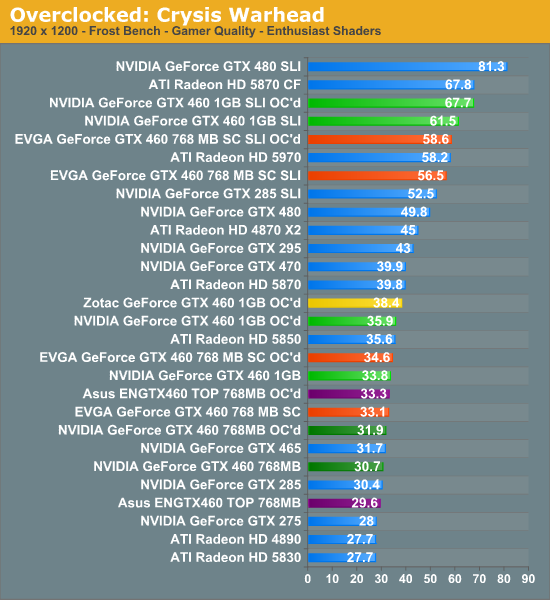

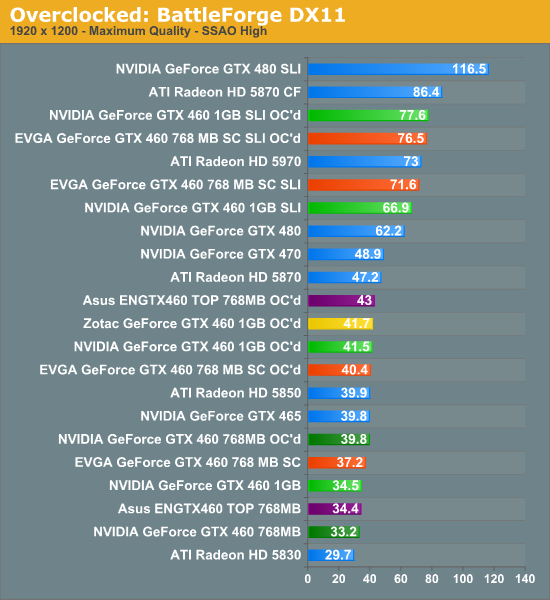
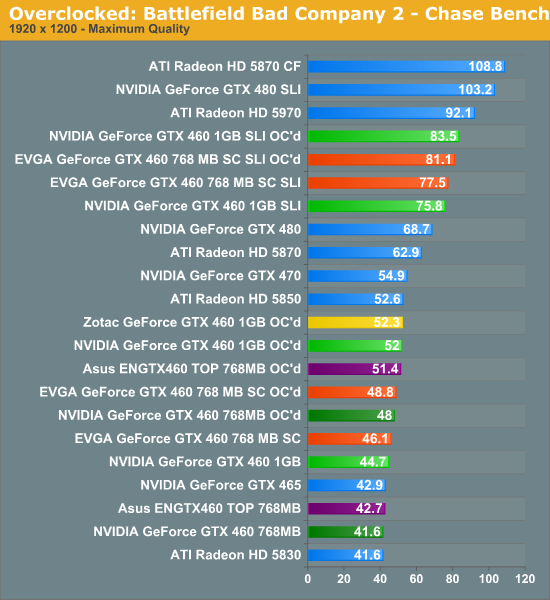
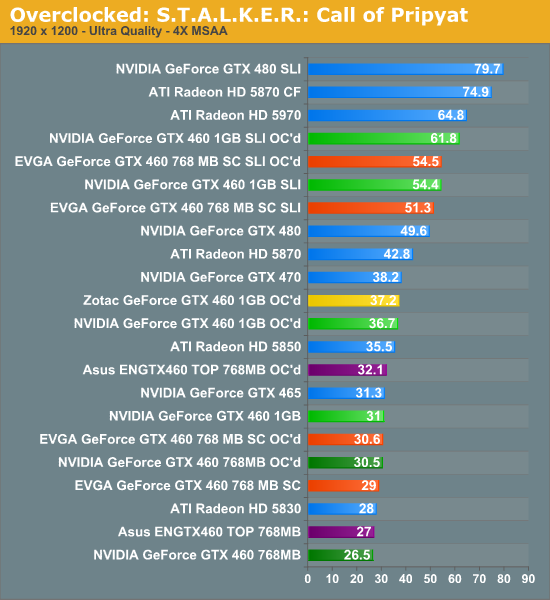
Overall the impact of overclocking is heavily game dependent. Core overclocking favors games that are ROP/shader limited and has little effectiveness on games that are limited by the total available RAM or by memory bandwidth. For this reason out of our subset of games core overclocking was most effective on Battleforge and Bad Company 2, while only moderately effective on Crysis and STALKER. On Crysis and STALKER overclocking was at best only marginally more useful than having a 1GB card. And even with its greater core overclock, the Asus ENGTX260 is not immune to this effect once the 1GB cards are overclocked – it still falls behind an overclocked 1GB card ¾ of the time.
Currently the sweet spot would look to be a 1GB card with a lesser overclock. The additional RAM/L2/ROPs more than makes up for the higher overclocks the 768MB cards can attain in most situations.
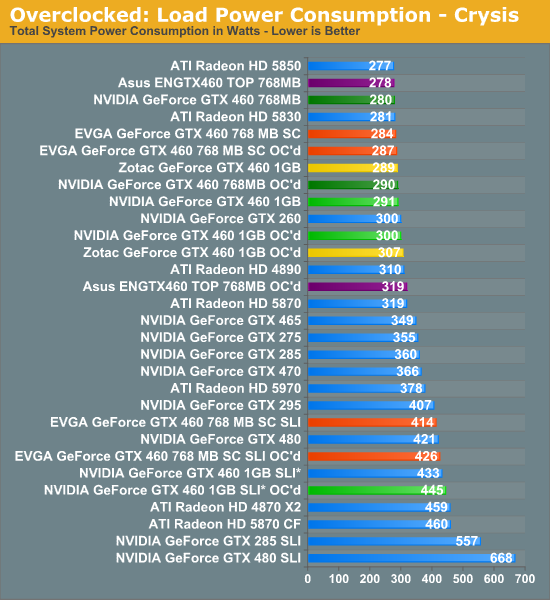
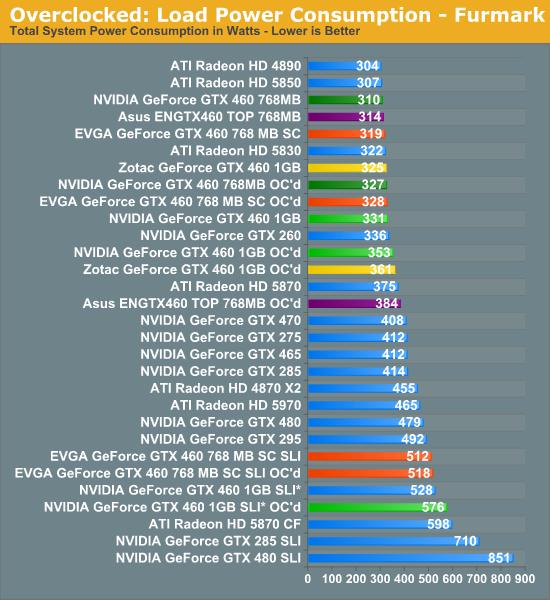
For the cards without voltage tweaking capabilities, the power consumption penalty for overclocking is very minor due to the fact that power consumption increases with voltage much faster than it does with frequency. For the stock-clocked cards this is a 15W-25W penalty, while the factory overclocked cards are even lower (thanks to binning) at just 9W. Meanwhile as expected the Asus card with its voltage tweaking capabilities ends up witnessing a larger jump in power consumption in return for its greater overclock capabilities: 70W.
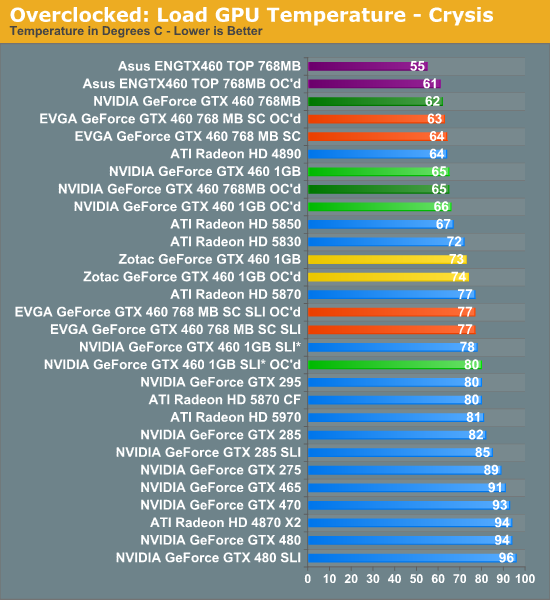
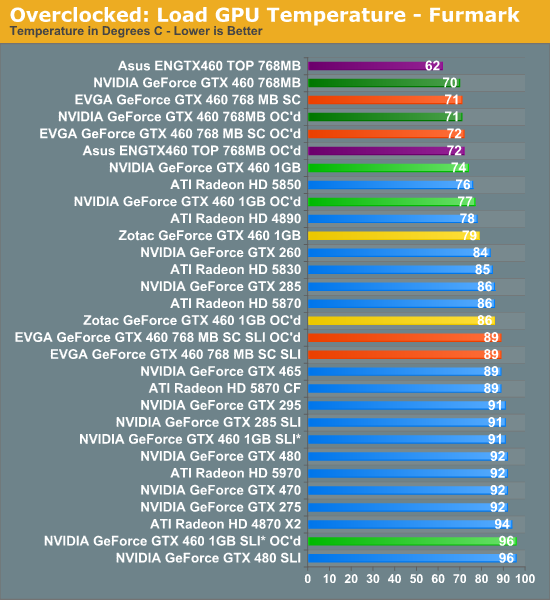
With only a minor increase in power consumption and the use of very efficient coolers, the GTX 460 only experiences a minor rise in temperature when overclocking without voltage modification. All of our cards with the exception of the Zotac under Furmark only rise in temperature by a few degrees, leaving temperatures well in the safe range for these cards. Even the Asus card with voltage modification stays fairly cool thanks to its more aggressive fan, rising by up to 10C under Furmark but still only becoming as warm as our stock-cooled cards in the first place.
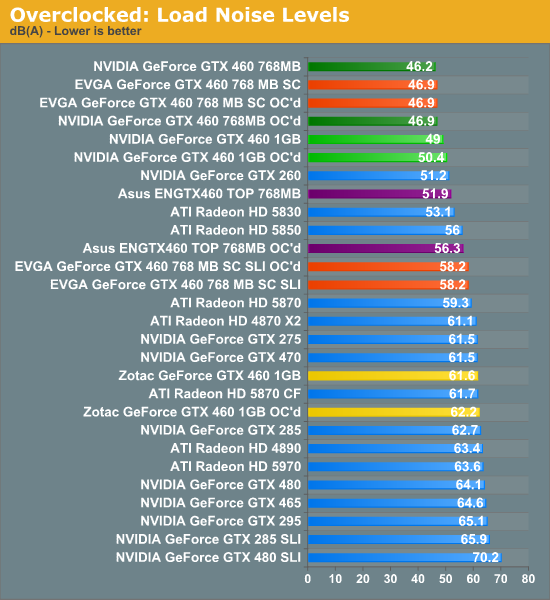
Last but not least we have the noise factor. Thanks to the very low increase in power consumption these cards experience when overclocking, the coolers on these cards have to do very little to handle the extra heat. For the cards without voltage modding, the amount of noise generated increased by less than 1.5dB, and in the case of our EVGA cards didn’t increase at all. This results in our GTX 460 cards remaining as some of the quietest mid and high-end cards we’ve ever benchmarked, even with a 24% overclock.
The Asus card is of course the exception to the rule here, once again due to a combination of the more aggressive cooler and voltage modification. Here the amount of noise generated shoots up by 4.4dB when overclocked, which is a fair trade for the overclock but is definitely going to be more noticeable than the rest of the cards in our collection.
With all of this taken in to consideration, there’s little we can do to argue with NVIDIA’s claims about the GTX 460’s overclocking capabilities. One thing we need to make clear before going any further though is this: overclocking is not guaranteed. In our briefings with NVIDIA, they have told us that they know not every GTX 460 can hit 800MHz+, which in turn is part of the reason why the stock clock is only 675MHz. We believe a majority of cards will be strong overclockers, but this cannot be applied to all cards. Buying a GTX 460 is still going to rely on the luck of the draw, only the odds are very good at the moment. So if you absolutely must have an overclocked card, then a factory overclocked card is still the way to go.
At this point if you do receive a strong card it makes little sense not to overclock thanks to the very small increase in power consumption (and as a result, temperatures and noise) that overclocking causes. This is as close to as free of an overclock as there can be for a video card, so run with it and enjoy performance approaching a Radeon HD 5850.
Finally, if you are going to overclock, what kind of a card should you be shooting for? As it turns out the reference cooler does a very good job of hitting a balance between cooling needs and noise, while Zotec’s cooler does worse and Asus’s cooler does better at a cost of additional noise. We will add that we believe that overclocked 1GB cards are a better way to go just like we believe that 1GB cards are the way to go when at stock clocks, but ultimately this becomes a matter of affordability.










93 Comments
View All Comments
jfelano - Monday, July 12, 2010 - link
I've already seen 5830's at $170 after rebate. So there goes that short lived Nvidia advantage.itsmekirill - Monday, July 12, 2010 - link
IMO the most important story here is not that it beats the HD 5830 or GTX 465, but that the SLI configuration is trading blows with 5870 CF and 5970.For ~450 dollars you can get comparable if not superior performance to an $800 CF setup or a $650 dollar 5970.
tcnasc - Monday, July 12, 2010 - link
Yes, that's what got me too!My 5870 feels so expensive right now
Should I sell it and buy 2 GTX 460?
fausto412 - Monday, July 12, 2010 - link
i didn't miss that...i got my 5870 3 weeks ago and i was like "wtf...this is a 200 dolalr card, it shouldn't do that well!"VIDYA - Monday, July 12, 2010 - link
good review but a bit partial towards the new born child(gtx 460, cant hold that kind of joy).......its pretty much still oranges and apples .....both are good and differ at a few games. Nvidia shouldn't have sold 480, 470, 465 and instead should be waiting back to mature the chip into 104gf.....think about the owners of gf100 chip reading this and cursing themselves for not holding back for a month. But all said and done from both sides, we all know that Nvidia is still no:1 when it comes to drivers and software support updates.SongEmu - Monday, July 12, 2010 - link
The quality and depth of these articles is exactly why I keep Anandtech bookmarked.Also, it's good to see nVidia with its headon straight. I was afraid I'd have to give up CUDA and all those other goodies on my next upgrade, because there was no way in GF100-hell I was going to buy a GTX470 toaster.
sparkuss - Monday, July 12, 2010 - link
I thought I looked at all the charts and I also didn't see any mention in the conclusion of 5850 CF vs the 460 1GB. Then again I'm old and senile so I have that going for me!I know the price differences but I would still like to see the comparison, especially if this could actually cause AMD to lower 5850 prices.
7Enigma - Tuesday, July 13, 2010 - link
Agreed. That would probably be the most common CF setup and certainly the most applicable from a cost-comparison standpoint. Sure it would be $600 vs. $400 but why have the 5870 CF which is even more crazy at $800 vs. $400?rocky12345 - Monday, July 12, 2010 - link
I read the review & it was pretty good & well written. It is good to see Nvidia get their act together somewhat. I am not a Nvidia fan any more lost faith in them when they started rebranding the 8800 series over & over again & I switched to ATI after that. I still have a 9800GT 1GB in one of my systems which I rebadged myself from a 8800GT 1GB & clocked it at 755Mhz core & 2200mhz memory it is fast enough for my secondary system for when friends come over to game.This new chip from nvidia makes a lot more sense than what they released a few months ago. Would I own on hell no. I already have enough money tied up in video cards in my main system as I own 2 4870x2 2GB cards highly over clocked crossfired until ATI comes out with a single card that can beat my 2 beasts in quad GPU I am fine with what I have.
Belard - Monday, July 12, 2010 - link
Right on, the GTX 460-768 should be a 455, its so NOT the same card.For the most part... why is idiot-Nvidia even bothering with the "GTX" part since their model numbers don't collide? ie: there won't be a GTX 460 and a GTS 460 or a GT 460... well, maybe... who knows.
The two 460's is designed EXACTLY to do what its going to do. People will buy the cheaper junk card and not get the performance they should get if they only spent $30 more.
Considering the age of the ATI 5000 series... it really should be EASY for ATI to reduce the prices of the line a bit.
The 5850 should be a $200 card by now. 5830 at $150, 5770 at $125... perhaps soon. 6000s come out just before Christmas?